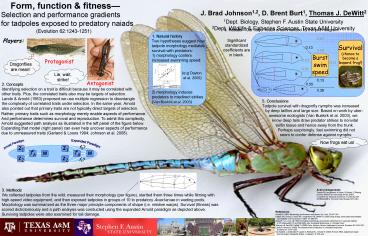Form, function - PowerPoint PPT Presentation
1 / 1
Title:
Form, function
Description:
... with high-speed video equipment, and then exposed tadpoles in groups of 10 to ... Survival (fitness) was scored dichotomously and a path analysis was conducted ... – PowerPoint PPT presentation
Number of Views:60
Avg rating:3.0/5.0
Title: Form, function
1
J. Brad Johnson1,2, D. Brent Burt1, Thomas J.
DeWitt2 1Dept. Biology, Stephen F. Austin State
University 2Dept. Wildlife Fisheries Sciences,
Texas AM University
Form, function fitness
Selection and performance gradients for tadpoles
exposed to predatory naiads (Evolution
621243-1251)
4. ResultsOur major result is summarized by the
path diagram
1. Natural history Two hypotheses suggest how
tadpole morphology mediates survival with
predators 1) morphology confers increased
swimming speed (e.g
Dayton et al.
2005) 2) morphology induces predators to
misdirect strikes (Van Buskirk et al. 2003)
0.01
Players
Significant standardized coefficients are in
black.
Survival (chance to become a leopard frog!)
0.13
0.04
Burst swim speed
0.01
Protagonist
Dragonfliesare mean!
0.11
0.01
Lie, wait, strike!
0.13
Antagonist
2. Concepts Identifying selection on a trait is
difficult because it may be correlated with other
traits. Plus, the correlated traits also may be
targets of selection. Lande Arnold (1983)
proposed we use multiple regression to
disentangle the complexity of correlated traits
under selection. In the same year, Arnold also
pointed out that primary traits are not typically
direct targets of selection.
0.55
0.38
5. Conclusions Tadpole survival with dragonfly
nymphs was increased by deep tailfins and
large size. Based on work by uber- awesome
ecologists (Van Buskirk et al. 2003), we
know deep tails draw predator strikes to
nonvital tailfin tissue and hence
away from the trunk. Perhaps
surprisingly, fast swimming did not
seem to confer defense against nymphs.
Rather, primary traits such as morphology merely
enable aspects of performance. And performance
determines survival and reproduction. To admit
this complexity, Arnold suggested path analysis
as illustrated in the left panel of the figure
below. Expanding that model (right panel) can
even help uncover aspects of performance due to
unmeasured traits (Garland Losos 1994 Johnson
et al. 2008).
Now frogs eat usI
http//www.dragonflies.org
3. Methods We collected tadpoles from the wild,
measured their morphology (per figure), startled
them three times while filming with high-speed
video equipment, and then exposed tadpoles in
groups of 10 to predatory Anax larvae in wading
pools. Morphology was summarized as the three
major principle components of shape (i.e.
relative warps). Survival (fitness) was scored
dichotomously and a path analysis was conducted
using the expanded Arnold paradigm as depicted
above. Surviving tadpoles were also examined for
tail damage.
Acknowldegements Thanks RB Langerhans, A Pease, B
Shipley, D Pfennig and two referees for
manuscript review, and to C Kaufman for
empirical assistance. Funded by NSF (DEB0344488
to TJD) and Dept. Biology, SFA (JBJ)
References Arnold SJ (1983) Morphology,
performance and fitness. Am. Zool.
23347361. Dayton GH, Saenz D, Baum KA,
Langerhans RB, DeWitt TJ (2005) Body shape, burst
speed and predator susceptibility of larval
anurans. Oikos 111582-591 Garland T Jr, Losos JB
(1994) Ecological morphology of locomotor
performance in squamate reptiles. In PC
Wainwright PC and SM Reilly, eds. Ecological
Morphology. U. Chicago Press. Johnson JB, Bert
DB, DeWitt TJ (2008) Form, function,
fitnesspathways to survival. Evolution
621243-1251. Lande R, Arnold SJ (1983) The
measurement of selection on correlated
characters. Evolution 3712101226. Van
Buskirk J, Anderwald P, Lüpold S, Reinhardt L,
Schuler H (2003) The lure effect, tadpole tail
shape and the target of dragonfly strikes.
J.Herpetol. 37420424.































